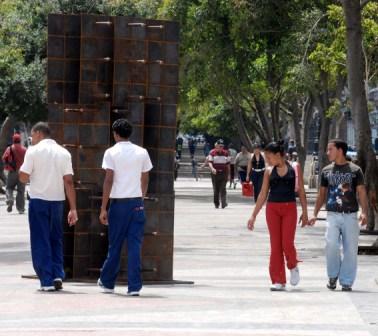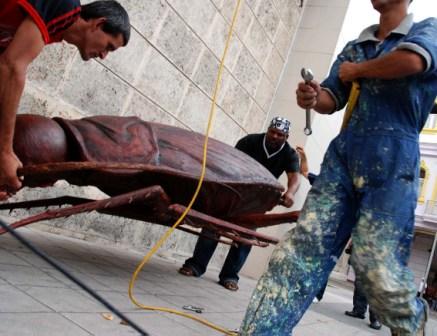Kafka in Havana
By Irina Echarry, photos: Caridad

HAVANA TIMES, March 29 – The Havana Biennial is one of the most anticipated events for artists in Cuba anxious to promote their work. The entire capital becomes an expansive gallery in which different genres, themes and points of views converge.
It attracts foreign artists, while Cuba’s masters take advantage of the event to make their works better known. The local media -trying to capture the attention of the majority of Havana’s residents- constantly cover what is or will be happening in those institutions that house the displays, sculptures, installations, performances and exhibitions.
But has all this gotten through to people?
Along the Prado Avenue esplanade, one of the sites most visited by those who live in the capital or just want to take a walk, the young and not-so-young stop to observe sculptures by José Villa Soberón, Tomás Lara, Ramón Casas, among other artists who chose that setting to display their art.
Martica, with a perplexed look on her face, said, “I don’t like them; they don’t say anything to me. I don’t think that even the artists themselves knew what they were doing.”

Ramsés, a little more disrespectful, commented jeeringly, “Next time I’m going to come here with a sack of potatoes and a pan. Then I’ll sit down and start peeling the potatoes in front of everybody. Nobody can tell me that that’s not art.”
He looked at me a bit alarmed when I told him that he should do it, that he should express himself, that art exists is for that very reason. Maybe a lot of people would suddenly get the message of family complicity in the act of peeling potatoes.
Others might see the parody, appreciating a harsh critique of the country’s lack of resources, when looking at a sack full of potatoes in a city with a worsening food shortage. Then too, others could find that in each slice made by the knife there existed a simile of the fragmented reality of many Cuban families.
I don’t think he got it. I ended up being the focus of ridiculing looks.
On the front of the Fine Arts Building is an array of huge cockroaches. Has Kafka’s Gregor Samsa decided to settle in Havana? Maybe he thinks this is a good place to develop his craft. You’d have to ask the author of the work, Fabelo, who watches attentively over the assembly.

From a car, a boy tries to calculate the size of the insects, which are pretty big. “I didn’t know that there were cockroaches with human heads,” he comments.
Innocence is part of childhood; it’s funny when they say things like that. However, it’s different when adults pose questions like, “Why did they put those heads on?” or comment, “Those bugs are disgusting… no way, I’m not going over there. I don’t like looking at them. And they have antennas!”

You’d have to wonder if Kafka had lived in Havana whether he would he have felt the need to write The Metamorphosis, or would he have found absurdity so common that he wouldn’t have noticed it?
Fabelo is sending a message with this work titled Survival. Perhaps he’s troubled by the decaying values of society, or perhaps thinking that the people who inhabit this planet are becoming less and less human. Or, maybe he’s simply announcing the apocalyptic fate of a nuclear war in which the only survivors will be cockroaches.
We are a people who learned to read and write a half century ago, who today receive classes on television, and who are informed about everything that happens in the cultural environment of the island and in a good part of the world. Shouldn’t a people like this be a little more receptive to art?
This is a city, which like all capitals embodies great diversity. What some people like, other can’t stand.
Maybe we also have to wonder if so many cultural events held during the year don’t saturate the thoughts of working people, those who are not so connected to the intellectual world; people who need to eat, pay for their kid’s shoes and have a good time without the pressure of feeling we’re in a cultured nation.
The Havana Biennial began on March 27, and we’ll have one month to learn the answer.
Click on the thumbnails to see all the photos in this gallery






























Cubans frequently laugh at the problems and contradictions of their lives. Sometimes this is what people in the United States call “laughing to keep from crying”, but there’s a lot of laughter in Cuba. That’s what the art work – statues of cockroaches, exemplifies. It also demonstrates considerable artistic technique, which the Cuban artists have learned, either in art school or in life on the island.
Irina Echarry seems to be one Cuban who mostly just complains, and who never puts forward any suggestions for making anything any better. Yoani Sanchez is another who seems to do the same thing. One wonders: does Irina Echarry every laugh?
Lots of nice photographs, however.